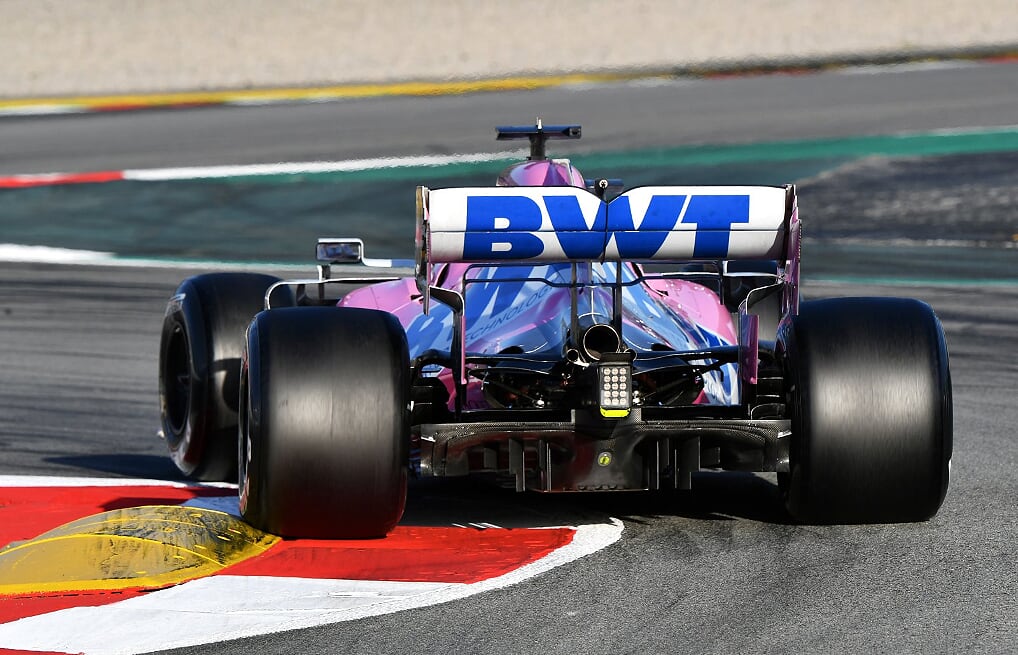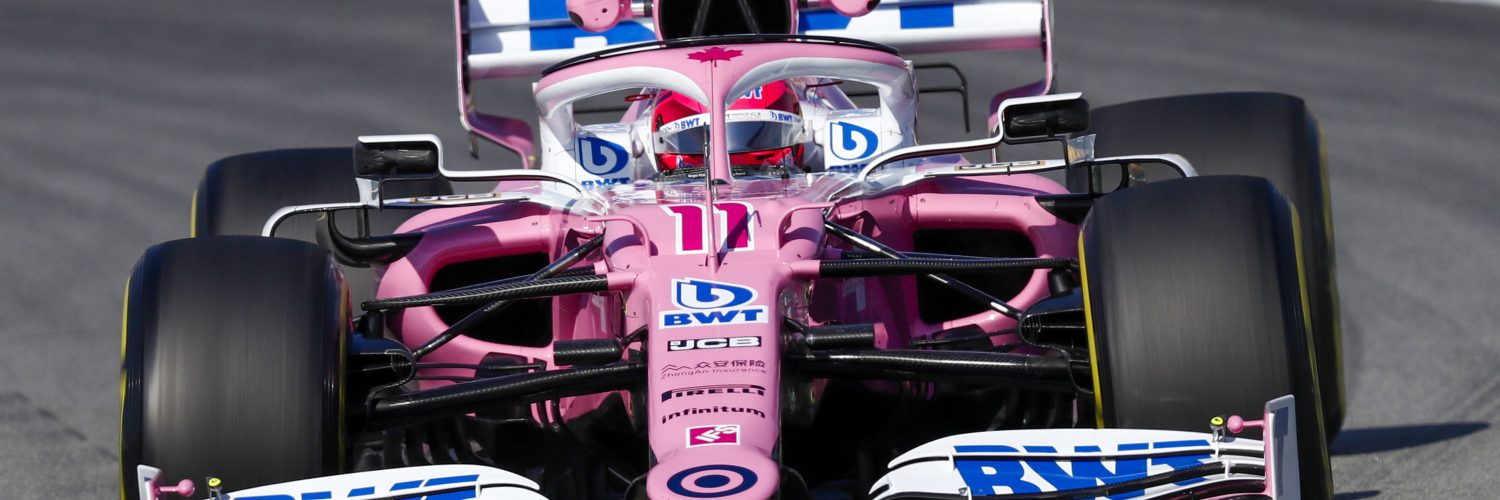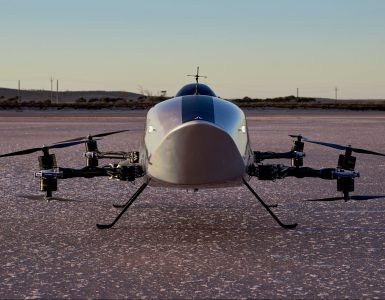Looking from the outside and seeing through the pink BWT paintwork, the Racing Point RP20 has a striking resemblance to the 2019 Mercedes W10. It transpires this was a conscious decision for Racing Point, but the resemblance is largely skin deep and transgresses no F1 rules.
Formula 1 is at the peak of the current technical regulations, heading into 2021 there will be a complete overhaul of the chassis regulations. For most teams this means they are refining their concepts developed over the recent seasons, honing their well-known designs with an eye of the 2021 redesign on the horizon. Racing Point, however, have gone the opposite way, taking a ‘risk’ on a total redesign for the penultimate season under the current rules. This has resulted in a crossbreed car, split between a car based on Racing Point design and Mercedes concepts. So, is this a cut and paste of the 2019 Mercedes or something a little more inspired?
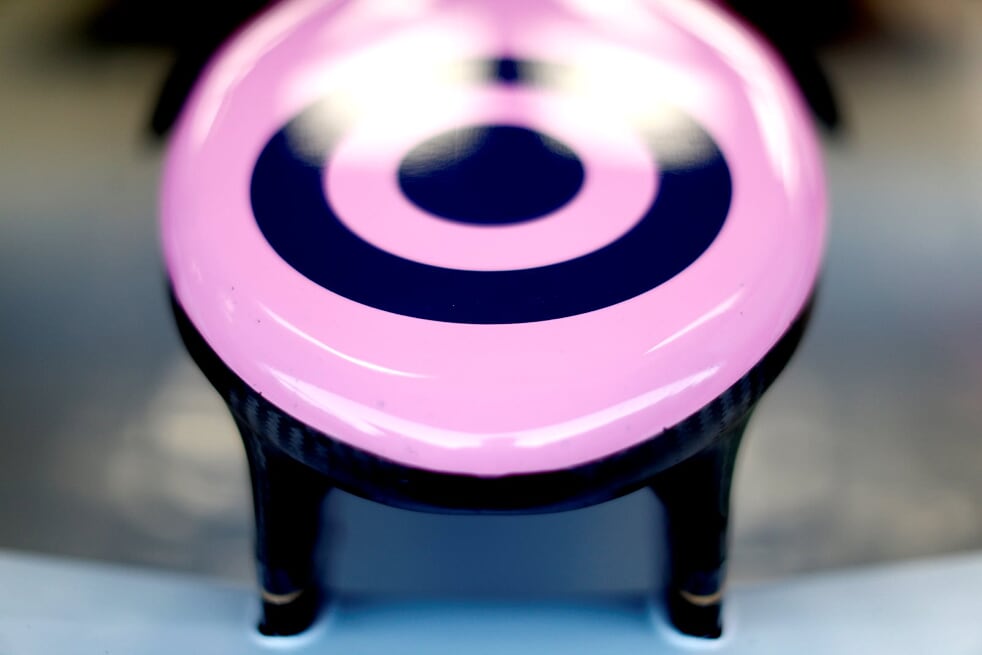
Racing Point is the latest title of a long running team history based at the Silverstone circuit in the UK. From its startling debut success as Jordan in 1991, the team have resolutely remained an independent team, taking power units and often gearboxes from a manufacturer, but leaving any closer technical ties at that level. 2019 was a rebuilding year for the team in its first season as Racing Point. Increased investment in the team brought stability the green shoots of growth as the teams’ facilities were developed. In the build up to last season the team redesigned the outgoing car and the RP01 started the year with the key on-trend F1 design tricks of high-top sidepods and raised front suspension. A slow start to the season soon saw the team catch up the midfield as RP01 design progressed.
By mid the season, the car’s series of redesigns meant it was at least on a par with the rest of the midfield, these updates were detailed here on Motorsport.Tech. It was at this point that the increased funding and impending new car designs for both 2020 and 2021 led to some strategic thinking at their Silverstone Design office. The question being, do they lightly evolve the RP01 design and focus early on the 2021 rule changes, or do they make a more concerted effort with the 2020 car to make a jump on the competition, before focussing on the 2021 season?
Heading this decision is Technical Director Andy Green, one of the four designers responsible for the Silverstone team’s 1991 car, who, after spells at BAR and Red Bull remains one of the teams many long serving staff. Given the new investment, the potential a performance leap for 2020 to follow the undeniable success of their partner Mercedes, the choice of a ‘big risk’ was taken.
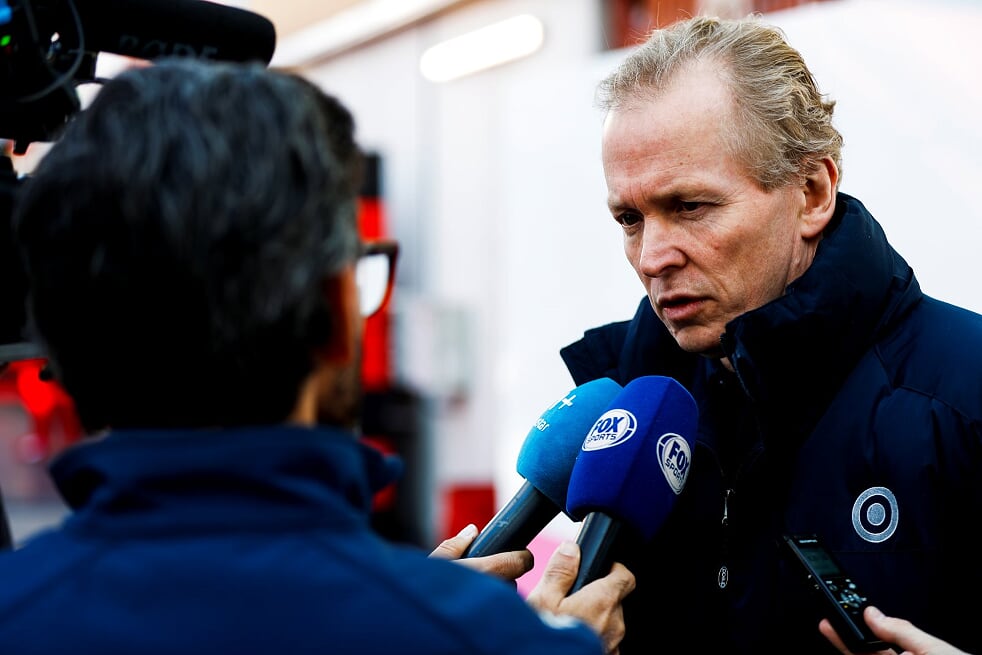
Rationalising this, Green figured that the Mercedes philosophy of the past six years had allowed them to dominate the sport, while their own simpler take on the Red Bull philosophy wasn’t getting them where they needed to be.
These two philosophies revolve around wheelbase and ride heights; Mercedes have run longer cars, with lower rear ride height, creating a flatter nose-down raked angle to the car in side-view. Red Bull conversely run a shorter car but much higher at the rear, creating a steeply raked car. Both create downforce from the either the length or the rake angle of the floor. Mercedes alone have furrowed the path of long wheelbase/low rake and taken all the trophies, while the other nine teams opted for shorter/raked cars and have struggled to keep up.
Through these six years the Silverstone team have run Mercedes power units and gearboxes. While Williams have also run the Mercedes power unit, but they have designed their own gearbox. For Racing Point this has tied them in to Mercedes decisions on the gearbox case design, which in turn affects wheelbase and suspension mountings. So, in effect they have been racing a shorter raked car, with a gearbox designed around a longer\flatter car. This has lead to compromises and the new direction takes this mismatch into account. Why tackle the obstacles of a high raked car, with a high rear Centre of Gravity and the aerodynamic hurdle of huge rear ground clearance? Why not follow Mercedes aerodynamic philosophy, given they have the matching rear end layout?
Thus, the RP20 has the 2019 Mercedes gearbox, and 2020 Power Unit, but now has closely followed the aerodynamic layout of the W10 that ran this set up to such great effect in 2019. But this is not the W10’s bodywork either in the carbon fibre reality or on the CAD screen. Rules prevent teams taking hardware and/or intellectual design property in certain areas. These are called the ‘listed parts’, which are the areas of the car the team has to design itself; these are the monocoque, crash structures, bodywork (Aero) and radiators.
As bodywork is defined as a listed part, Racing Point have had to make their own designs from scratch, despite the resemblance to Mercedes designs. There can have been no data transfer or parts sharing on the aero side of the car. Instead the team have had to look at the 2019 Mercedes from photographic sources and create entirely new drawings for the bodywork. For a replica 3D model for TV or gaming purposes, making it ‘look like’ the Mercedes is a ‘relatively’ straight forward task. However, for a fully working F1 car, the team need to understand why the part is that shape, how it works and then make it work on their design. This would have been a huge process and not one that is the easy route to take. In itself this is a huge risk, problems correlating the predicted performance of the designs in simulation to the reality of the race car on track, mean that it could be easy for the team to get lost in their understanding of the car and achieving their performance goals. So far testing has proven the design step has jumped the team up the order, how this maps out through the season will be a tough test for Racing Point.
Based on looks alone
To look at the RP20 the change from the mid-season spec RP01 is significant. Perhaps the biggest change away from the wheelbase/rake dimensions is the return to low sidepod inlets. It was only in 2019 that Racing Point caught up on the Ferrari lead concept, restructuring the side of the monocoque and its crash structures to move the sidepod inlet higher, to create a deeper undercut below to route more airflow over the floor and diffuser for more downforce. Mercedes only followed this route in 2020, so the 2019 W10 still had lower albeit tightly packaged inlets and sidepods. To comprehensively follow the W10 aero philosophy demanded the RP20 also take this reverse step in sidepod layout.
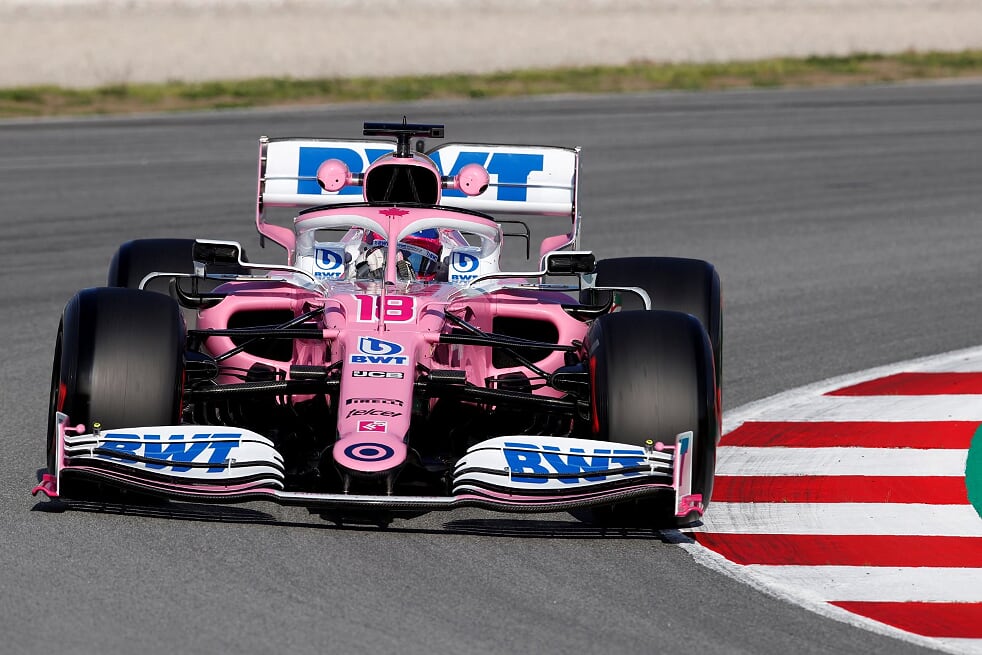
At the front the visual changed is marked too, the wide thumb-tipped nose has been replaced with the trademark narrow rounded nose of the recent Mercedes designs. This narrower nose works well with the cape under the nose. This sweeping aero device is another Mercedes trademark, the narrow nose encourage airflow over the edges of the cape to make it function as a vortex generator ahead of the main bargeboards/turning vanes.
Around the mid area of the car, the aforementioned sidepods are allied to the bargeboard and floor edge package. These are also close in concept to the W10, even with the downward curved fins on the chassis side incorporated on the Racing Point.
While the roll hoop inlet with its inlet split for the engine’s airbox and ERS radiators was already in place on the RP01, as was the general sidepod shape. Design again converges with the specific geometry of the W10 around the rear wings, the two element T-wing mimics the Mercedes as does the serrated cut out on the rear wing endplate.
What’s on the inside?
As much as aerodynamics account for a lot of the car’s performance, there still a lot under the skin of the car that needs to be designed and also becomes split between Mercedes and Racing Point ideas.
As described before, Racing Point have to design the monocoque, crash structures, radiators, brake ducts and bodywork. So, even if the designs take heed of the needs of the Mercedes aero concept, the work underneath to design and make them, has to come from the Silverstone design office.
Conversely the Non listed parts can be either a team’s own design or bought in, these can include power unit, gearbox, exhaust, electronics, suspension inboard/outboard, steering, hydraulics, fuel system, wheels, brakes, steering wheel and cockpit controls.
If we take Haas as the example of a purely listed parts constructor, they take nearly that full list from their partner, Ferrari. While Toro Rosso take a mix of those parts from Red Bull. Racing Point appear to be split in the supply of parts.
There is a clear comparison of the front and rear outboard suspension, the high positioning of the front wishbones was a feature of the 2019 Racing point and the new car appears to edge closer towards the Mercedes 2019 geometry, complete with the extreme pushrod-on-upright (POU), as the pushrod mounting sits outside of the brake duct, in order to lower the front ride height when steering. Again, something Racing point exploited in 2019, but the new car simply follows the Mercedes concept much closer.
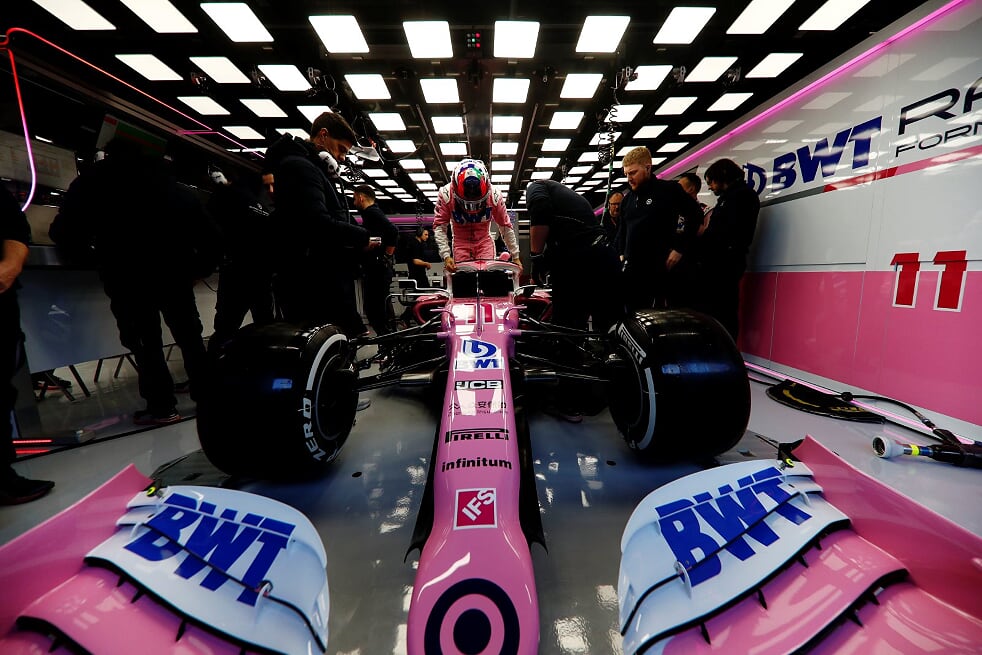
Things are different on the inboard suspension as far as we can see so far, the rockers, springs and dampers that sit inside the nose of the car are totally different to the Mercedes. This is a key area of Mercedes technical superiority in F1, which underlines this isn’t simply a wholesale copy of Mercedes design, merely limited to the design areas with aerodynamic influence.
Likewise, within the sidepods the cooling layout is different, despite the identical power Unit and similarity in external sidepod shape. Since 2014 the Mercedes team have run an air to water intercooler. So, rather than cooling the charge air compressed by the turbo in a heat exchanger fed by cooling airflow, instead there is a water jacket around the intercooler that first takes the heat away. This heated water then gets cooled in a separate radiator in the sidepod. This is a slightly more complex and heavy solution, but Mercedes find a packaging benefit from this layout. Mercedes customer teams all use an air to air intercooler, so despite the other similarities, the lefthand sidepod features a large intercooler, thus diverging from the wholesale Mercedes aero concept.
Without a definitive list from Racing Point or Mercedes, the other shared parts are harder to pin point, for example the steering rack looks like the distinctive Mercedes 2019 design, perhaps part of a package linked to the hydraulics system driven off the engine and controlling most of the Power train functions.
One declared variation from the 2019 Racing Point technical partner list is the brakes. The team have had long associations with AP Racing and latterly 920e, now they use the same Brembo set up as Mercedes.
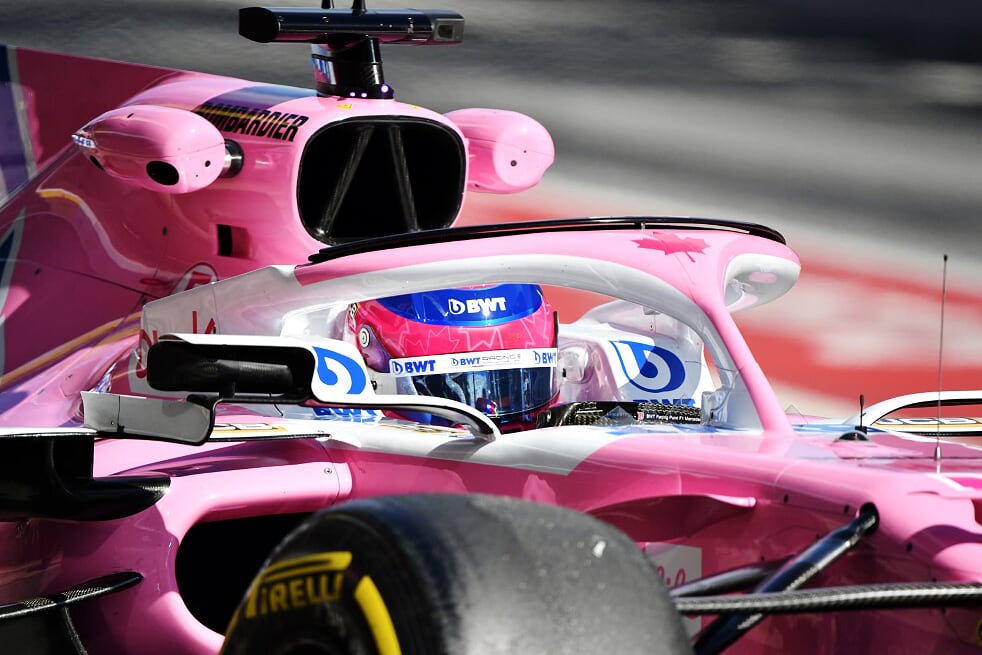
Will the new aero design philosophy pay off?
Winter testing is a notoriously hard means to measure a team’s true performance. This year Racing Point showed to be impressive based on their peak laptimes, has this risk paid off already, are they going to be at the head of the midfield or even catching the top 3?
It’s best not to jump the gun too early, only the opening races will show the teams true potential. Taking a listed parts approach is a quick way to get a head start on laptimes, but this comes not without its risks.
A look at Haas shows the potential pitfalls, in its four years the team had a quick start to their first season in 2016 with a sixth position in their first race. Only for them to struggle to with understanding their braking set up bought from Ferrari. Season 3 was their best year only to be hit by aero and tyre issues in 2019, almost ending up last in the championship!
Racing Point may have similar issues, will on track reality show the Mercedes-inspired aero not to be working as they expected? How quick will they be able to recover from any such setbacks on either aero or bought in systems? Then how will they develop through the year, improving a design that had already served its time by the end of 2019? Then how will this affect their focus on the huge challenge of 2021?
Ahead of the first race of 2020 we will have to see if their gamble pays off with risk or reward.
